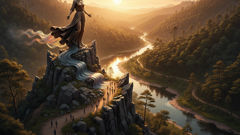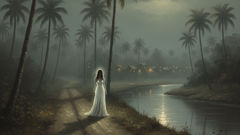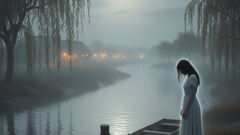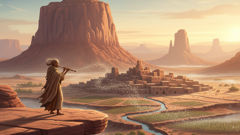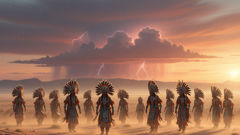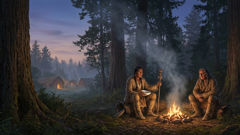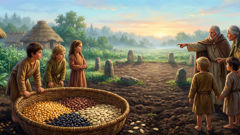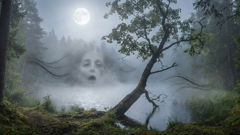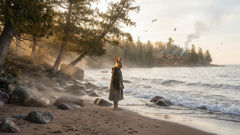Introduction
On the rim of a vast mesa where wind sculpts sandstone and sky stretches like a painted cloth, elders once spoke with a voice that braided history into the present. This telling is a careful retelling of the Hopi Emergence Story, the narrative that holds the people’s memory of rising through a succession of worlds, learning the language of seasons, and being taught by spirits who guided every step upward. In the hush before dawn, when the mesa’s shadow still sheltered sleeping corn, the story began: a deep passage below the feet of humankind, a narrow crypt of earth and trial that birthed a people into a sequence of worlds—each world a lesson, each passage a testing place where choices were made and destiny, slowly, was taught. The earliest people lived in the dark of the lower worlds; their eyes adjusted to blackness, their hearts adjusted to one another. They called upon helpers in shapes and names older than language: the Benevolent Twin, the Spider Grandmother whose fingers spun paths of light, coyotes who loved mischief more than mischief loved them, and soft-voiced women who carried seeds in their palms like prayer. As the story unfolds, you will meet the four worlds—each a quilt of meaning and element—through which the people climbed: a first world of dense earth and cramped lives, a second of water and shifting identities, a third of fire and volatile hearts, and the fourth where sunlight and open sky allowed corn and clan to thrive. This narrative seeks to paint those worlds in sensory detail, to honor the cadence of the telling that has been handed down around hearth and ceremonial place. It is not a claim to replace the voices of Hopi keepers, nor an exhaustive rendering of ritual. Instead, it is an interpretive and respectful retelling aimed at honoring the rhythm of emergence: how struggle becomes instruction, how community is born from shared passage, and how a people grew to know themselves in relation to land, sky, and one another. In this version, I invite you into the hush between breath and dawn, to listen closely to footsteps on stone, to feel the weight of seed and the grain of time, and to walk—carefully, with respect—through the four worlds of the Hopi imagination. Allow the landscape to speak, let the figures move like shadows that hold light, and hold the story as a mirror to the human impulse to ascend, to remember, and to steward.
Through the First World: Tight Earth and the Lessons of Community
The first world lay beneath the feet like compacted memory—earth pressed close enough to dim the sky, low and narrow as the inside of a seed. In this world, the people were closer to one another than they had yet learned to be, their movements guided by touch and whispers as the light was not yet something they knew by name. Chambers of stone and roots braided corridors that smelt of damp soil and the slow breath of the planet. Here, the oldest voices of the story say, the people found their earliest kinship—there was no place for isolated sorrow: in cramped passages one’s breath warmed another’s shoulder, and survival itself became the first teacher of community.

The narrative dwells on the textures of that dark world. Fear is present, but so are tenderness and a kind of fierce sharing. Mothers carried infants close like kernels tucked into husk, and elders laid hands upon foreheads to calm feverish nights. The Spider Grandmother, an archetypal helper in many variations, appears here in subtle forms: a quiet presence who weaves light into the dark, a patient figure who teaches the first web-patterns of order and connection. In the retelling, her silk is described as threads that capture the memory of voices, each filament holding a phrase of counsel: 'share your warmth, name your neighbor, keep your story.' These are practical lessons—how to divide the scarce water left in a hollow, how to carry seeds so they do not roll away in sleep—and they are spiritual lessons about reciprocity. The narrowness of the first world forces intimacy and exposes the rawness of human need. It is the pressure-cooker in which the earliest forms of obligation and mutual aid are forged.
But the first world is also a place of imaginative fertility. Under the weight of earth, the people dream more vividly; their imaginations must make room where there is not. Stories begin here—small songs and chants that name the particularities of life below ground: the smell of crushed sage, the taste of roasted roots, the sound of water dripping through stone into tiny pools. With each retelling some motifs crystallize: a coyote who speaks half-truths and half-tricks, a twin pair that models balance and contradiction, and a small luminous door that should not be opened until a voice from above directs. In some versions of the tale, an elder notices that the darkness grows thin in places, that a thin seam of sky leaks light like a wound above. Curiosity, like water, finds a way. The characters remember waking to a faint chill from a sliver of air. Those who were brave and those who were restless pressed upward until the rock thinned to a crack.
The ascent from the first world is, in narrative terms, also an initiation. Leaving the tightness behind means leaving behind certain comforts: the total certainty of knowing who you touch every night. The passage tests whether the people can carry the social lessons of sharing into a world where resources might be measured differently. As they crawl, as they squeeze through narrower seams and lift their faces toward the first gray lights filtering through, there is both hope and skepticism. Some characters cling to the old hollows, fearful that the unknown will unmake the fragile balance they have built. Others feel an irrepressible pull—an urge to see whether the light correlates to a wider sky. Those who choose to push onward do not merely escape darkness; they choose the labor of translating small-world ethics into practices that can survive exposure. The first world remains in them: a habit of carefulness, an underscoring of communal obligation, and an inherited taste for story as a means of survival.
Throughout this phase of the tale the landscape itself functions as a teacher. The earth shapes how bodies move and how voices are pitched; it shapes the terms of cooperation. The people also learn to make tools suited to compressed spaces—short-handled diggers to pry at soft seams, sharpened bones that scrape roots clean, small lamps that burn tallow sparingly. These inventions, in the storytelling, carry moral weight: every small tool is a choice toward foresight and generosity, since it becomes a resource to be shared. This framing encourages the listener to see technology and ethics as intertwined rather than opposite. The lessons of the first world set the stage for the larger moral arcs: how a society organizes care under pressure, and how the impulse to move upward is born out of both curiosity and a desire to widen the circle of care. By the time the people break through into brighter air, they bring with them not only the memory of how close they once lay but the seeds of social practices that will shape later worlds. They are changed by darkness, tempered like a blade in slow heat—ready, perhaps, to meet water or flame with a learned tenderness that originates under the weight of earth.
Water, Fire, and the Third World: Trials of Identity and the Emergence of Tradition
When the people emerged from the first world, the second revealed itself as a world of water—a landscape that rearranged identity itself. Where earth had compressed, water expanded: caverns opened into flooded basins, channels ran like silver tongues, and life was measured by the sway of current and the presence of reflection. In retellings, the second world tests recognition: who are you when the shore moves beneath your feet, when the sky mirrors your face and you do not know whether the person in the reflection is friend or stranger? The people learned to move by buoyancy rather than compression; they learned language that accounted for flow and the ethics of passage—how to cross another’s wake with respect, how to carve channels without erasing someone else’s path.

The water world is rich with sensory symbolism. Sounds are different—multiplicities of echoes make words shimmer; touch is diluted; the smell of damp reeds fills the air. In many versions, the helpers here are watery beings who teach navigation by listening rather than naming. These teachers instruct the people in rhythm: the time to drift and the time to paddle, the patience needed to hold seeds above water until soils can be found. The water world also tests trust. Currents can hide hazards; deep pools conceal sharp rocks or sudden whirlpools. Those who are impulsive often find themselves separated, carried into underwater hollows. There are stories of small groups learning to bind themselves together with braided cords so their fates remain linked: an early metaphor for social cohesion that will resurface as ritual ties in later, sunnier worlds.
Moving through water, the people develop new rites. They invent songs for crossing, simple measures for marking safe channels: a stack of three stones at an inlet, a reed tied to a stalagmite to measure rising tides. Here we find the beginning of ritual as a technology of memory. The group practices foraging patterns that respect seasons and water rhythms; they learn to store food in watertight pits and to build low-lying reed rafts when necessary. Importantly, identities begin to harden: families that once braided hair together begin to mark themselves with specific pigments or patterns that cling to the skin like secret maps. These marks are pragmatic—helpful in murky waters—but they also become symbolic, the early forms of clan markers and ceremonial design.
The third world arrives as a contrast: a world of fire and unpredictable open flames, where heat compresses time and decisions must be made quickly. Fire both purifies and threatens; it reveals as much as it consumes. In the story the people who arrive from water find that their old ways of moving must be rethought in the presence of flame. Where water cultivated patience, fire demands immediacy. Tasks must be executed with attention to sparks and embers—cooking requires vigilance, a lapse costs everything. The third world crystallizes character: those who are quick to anger are tested by the astonishing and dangerous capacity of flame to leap and alter landscapes. Yet fire is also a furnace of creativity: pottery, fired clay, and hard ceramics become possible. The people make new tools for agriculture and new vessels for storing corn seed. They invent processes that transform raw materials into durable forms. As with the first world, technology here carries moral consequences: choices about how to manage fire become choices about who will thrive. Those who hoard fuel risk community calamity; those who share hearthlight ensure seasonal survival.
Across the heat of the third world, spiritual instruction intensifies. Figures in the tale—sometimes labelled as messengers, sometimes as elder spirits—speak in parable. They issue paradoxical counsel: 'Use fire to soften what binds you; do not let flame sharpen selfishness.' The story’s protagonists come to understand balance through contradiction. They are taught to temper speed with deliberation, to let flame kindle both cooking and communal warmth rather than weaponization. A defining aspect of this world is the emergence of ritual forms that will persist when the sun finally floods the fourth world: dances around a communal fire, patterned offerings, and the shaping of masks and figures used to call rains and honor ancestors. These ceremonies instruct the young in communal memory and provide visible ways to pass lessons learned under pressure.
The journey from water to fire is itself a story of maturation. It charts a progression from malleability to definition, from reflection to action. The people who move through these worlds are not blank vessels; they carry marks and songs and the careful ethics of the first and second worlds into each new trial. The third world asks whether identity will ossify into rigidity or be shaped into resilient tradition. Some groups resist, choosing instead to remain in a liminal space between flame and cooling shadow; others accept the forging and emerge with practices meant to regulate appetite and power. These practices—rituals, taboos, and shared harvest rules—will be essential as the people cross into the fourth world.
When the fourth world opens, its sky is wide and bright. Sunlight pours like consent, and the mesas are revealed in full, the agricultural terraces and seed-bed expanses the people now build. The fourth world is a genesis of community institutions: formalized clan systems, agricultural cycles aligned to celestial movement, and the ceremonial calendar that orders life. Corn becomes central—not only a staple but a symbol: of sustenance, of covenant, of the people’s reciprocal relationship with the land. The Hopi, in the retelling, emerge into an ecology where their previous lessons are now practices: they share water in irrigation canals patterned by memories from the water-world, they build communal hearths that honor fire-world cautions, and they carry the closeness of the first-world ethics into structures that bind clans and clans into a nation. The fourth world is where memory accrues into tradition—a tapestry of songs, dances, kachina figures, and rules that guide cultivation, marriage, and ceremony.
The Emergence Story, in this layered, human retelling, thus maps the transition from survival to stewardship. Each world leaves marks on character and culture: intimacy forged under pressure, fluid identity learned through water, focused transformation in flame, and the bright sobriety of life in open sky. The tale is, finally, an instruction in how to live with difference: not to erase difficulty but to make practices that carry the hard lessons forward. It also cautions that emergence is not a single escape but a series of obligations—the people who rise owe themselves to those lower worlds by remembering how to respond under pressure and how to tend the fragile life of community.
Conclusion
The Emergence Story, as retold here, is a layered map of human becoming. It offers lessons about how small-world ethics scale into large-world institutions: the intimacy of the first world teaches care, the second world teaches listening and shared passage, the third world teaches craft, urgency, and the ethics of power, and the fourth world shows the long work of sustaining life in full sky. For the Hopi people, this story is not merely an origin myth but a living compass—one that instructs agricultural cycles, ceremonial life, and obligations to one another and to the land. When one holds the Emergence Story with respect, one sees its insistence that memory matters and that the ways we survive shape the ways we govern. This retelling aims to honor those contours: to bring forward the sensory detail of the worlds, the moral tests faced by people who choose to ascend, and the practices that arise from each trial. It remains important to remember that such stories are also sacred teachings retained by cultural custodians; entry into them requires humility and deference. As a narrative, the Emergence Story invites readers to listen: to the land’s long voice and to the idea that being human is a continual emergence—through challenge, through ritual, through the hard work of remembering how to live together.


